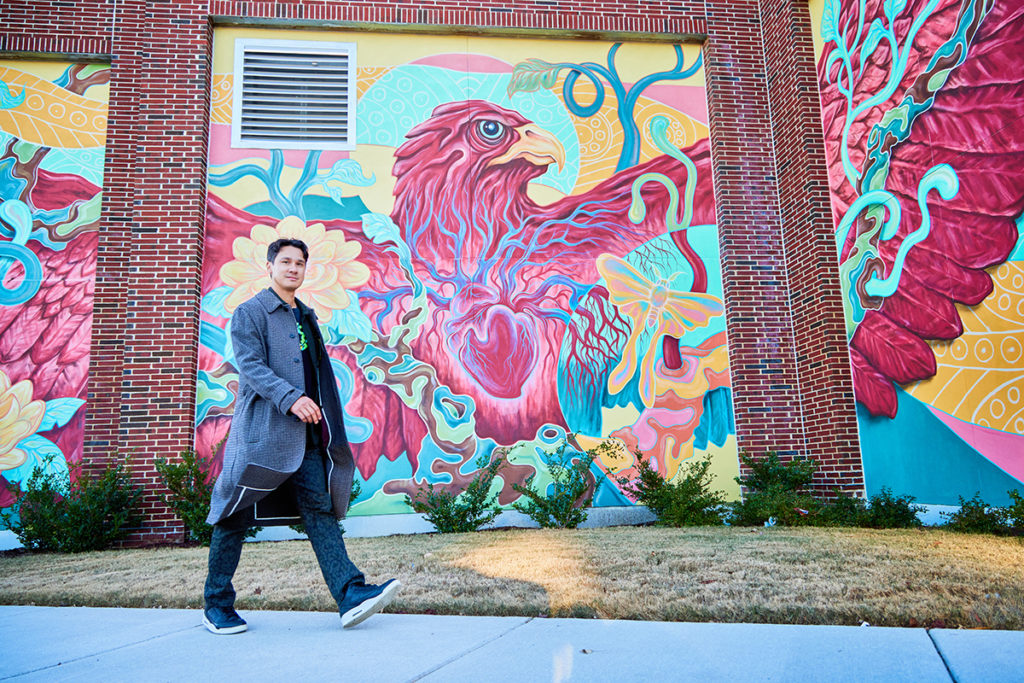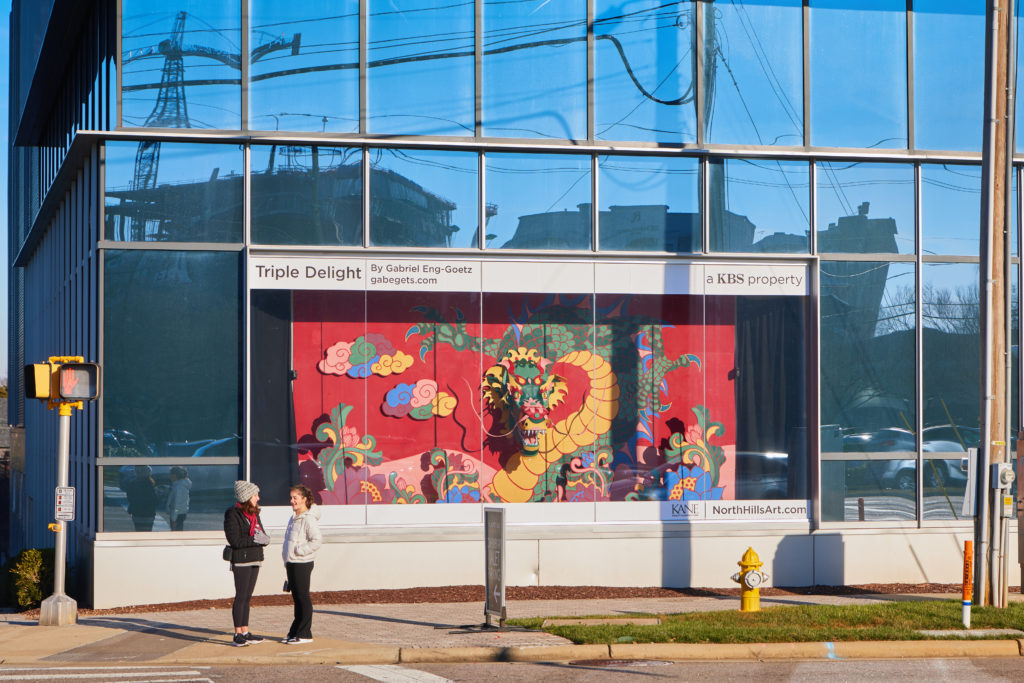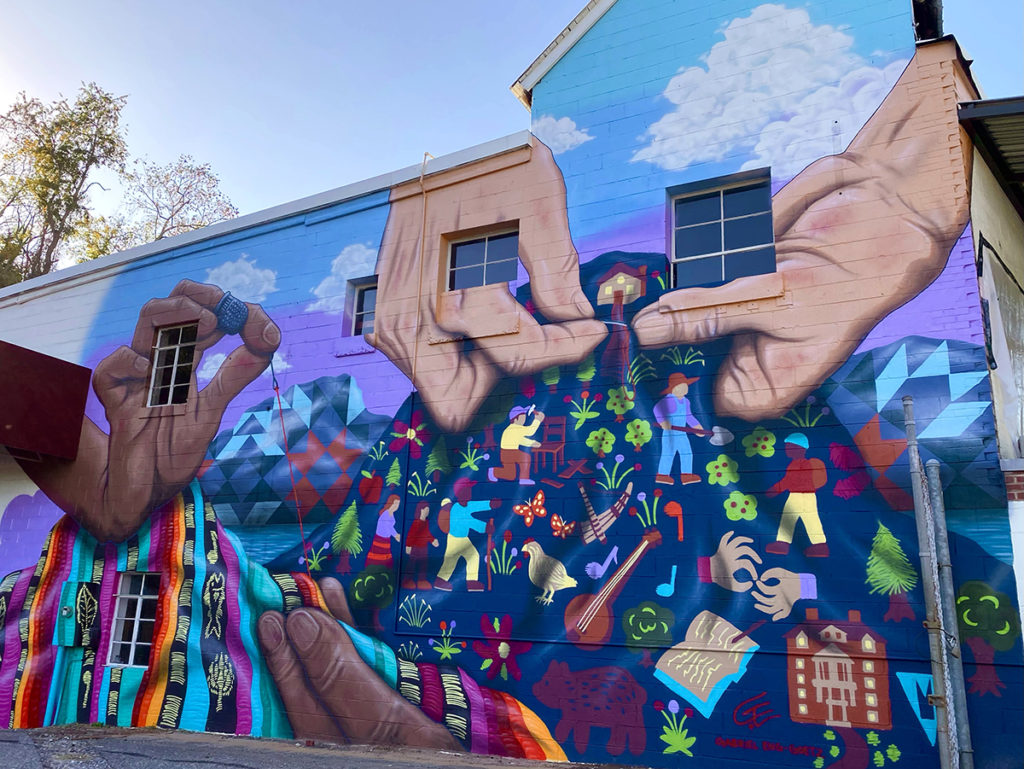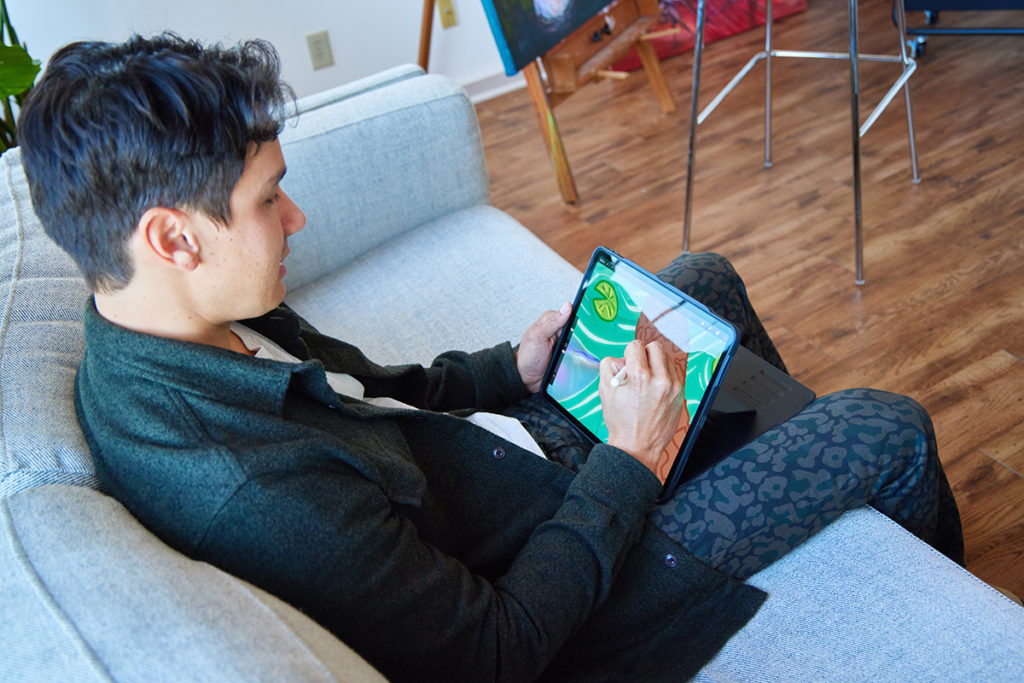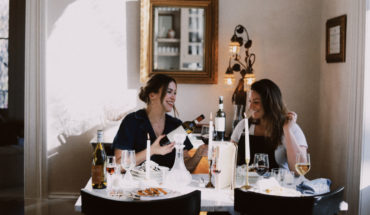The Durham native is known for colorful art that incorporates graffiti motifs, Asian icons and carefully woven stories.
by Colony Little | photography by Terrance Jones
In the Chinese Zodiac, we’ve just started The Year of the Rabbit: it runs from Jan. 22 to Feb. 9, 2024. According to this ancient system, the rabbit symbolizes skill, patience, gentleness and speed. And in Durham, the hare became the sidekick of a child in the logo for Runaway, a brand that encouraged an escape from convention.
Founded by artist Gabe Eng-Goetz in 2014, Runaway was a graphic design studio, streetwear design house and brick-and-mortar venue in the Trust Building on West Main Street, near the 21c Museum Hotel. In his artwork, Eng-Goetz fuses the cartoonish characteristics of pop surrealism with elements of imagery like skulls, flames and buxom beauties — icons synonymous with anime and tattoo design culture. His work features fantastical characters that rise out of or disintegrate into their lush surroundings.
This underground artistic style was often used in album art for musicians, producers and DJs including Savoy and Wolfgang Gartner. “I love all types of music,” says Eng-Goetz. “In the age of digital listening, the album is a lost art — I grew up with CDs, and it was very cool to me to go through the whole booklet, for the album to have a cohesive aesthetic. The album is what drew me into a lot of artists that I still listen to today.”
Eng-Goetz, who grew up in Durham, received a BFA in illustration with a minor in sculpture at Syracuse University in New York. As an undergrad, the artist was influenced by the synergies among visual art, music and fashion he experienced when he traveled to New York City on weekends, summers and other school breaks. “Being exposed to the New York art and fashion scene, I saw the power of streetwear and its ability to work with the creative community,” he says.
Runaway became a creative locus for music, spoken word and visual art in Durham’s downtown district. “When a lot of people think of the arts, they think of New York, Los Angeles, Miami — the larger cities,” says Eng-Goetz. “But I really feel that the Triangle is a creative hotbed. The arts are informed by local politics, and in the words of Outkast, the South has something to say.”
In January 2019, Eng-Goetz made the difficult decision to shutter Runaway’s physical location. “Retail is a full time job in a competitive industry,” says the artist. The move gave him space to shift toward fine art and public art projects. “I wanted the challenge of going big,” he says. His first large-scale mural was a vinyl wrap featuring a stampede of bulls placed on the side of the Morgan Rigsbee Garage.
Throughout 2019 Eng-Goetz continued to scale up. He completed his first hand-painted mural on the lobby walls of his coworking home, American Underground, across the street from Runaway’s former shop. In the piece, a menagerie of indigo frogs, birds, fish and insects frolic in flowing river currents among emblems of technology including light bulbs, cameras and electronic power cables that morph into pink-hued vines. This juxtaposition among the elements of nature, technology and new urbanism is a theme that Eng-Goetz explores in many of his murals.
A year later, at the beginning of the pandemic, what started as a six-week artist retreat in Nicaragua turned into a four-month sabbatical. While there, Eng-Goetz befriended an owner of a coastal hostel for tourists. In exchange for room and board, Eng-Goetz painted another large-scale mural. “It wasn’t anything too conceptual — basically a life-size great white shark with a lot of stylized, trippy elements,” he says, citing large gashes in the shark that reveal the dayglow rainbow-colored flesh. “It’s very surf hostel.”
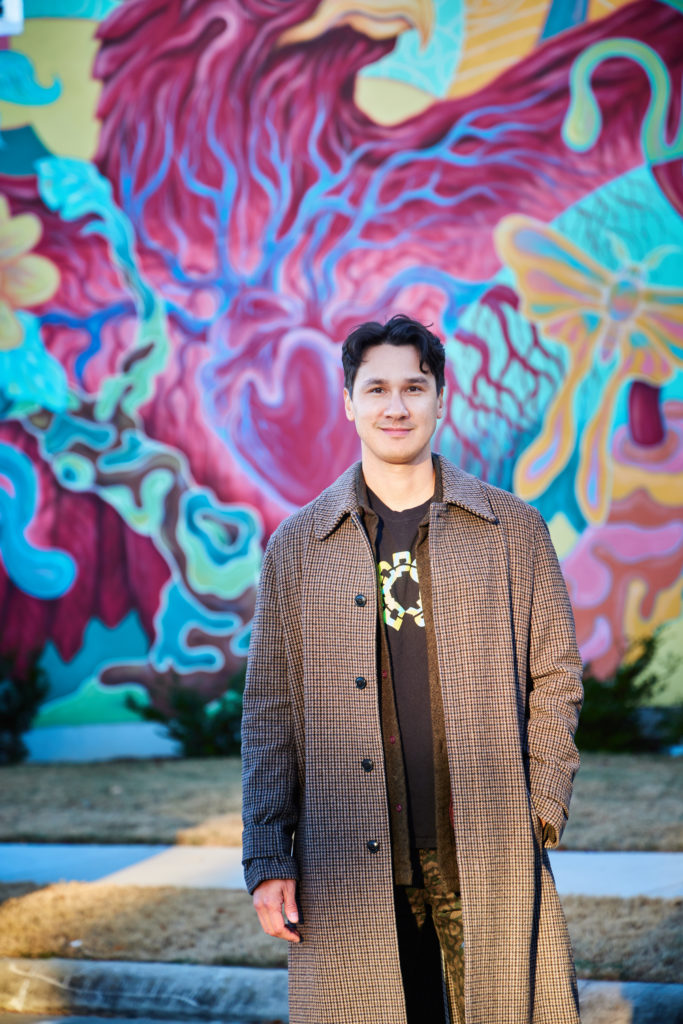
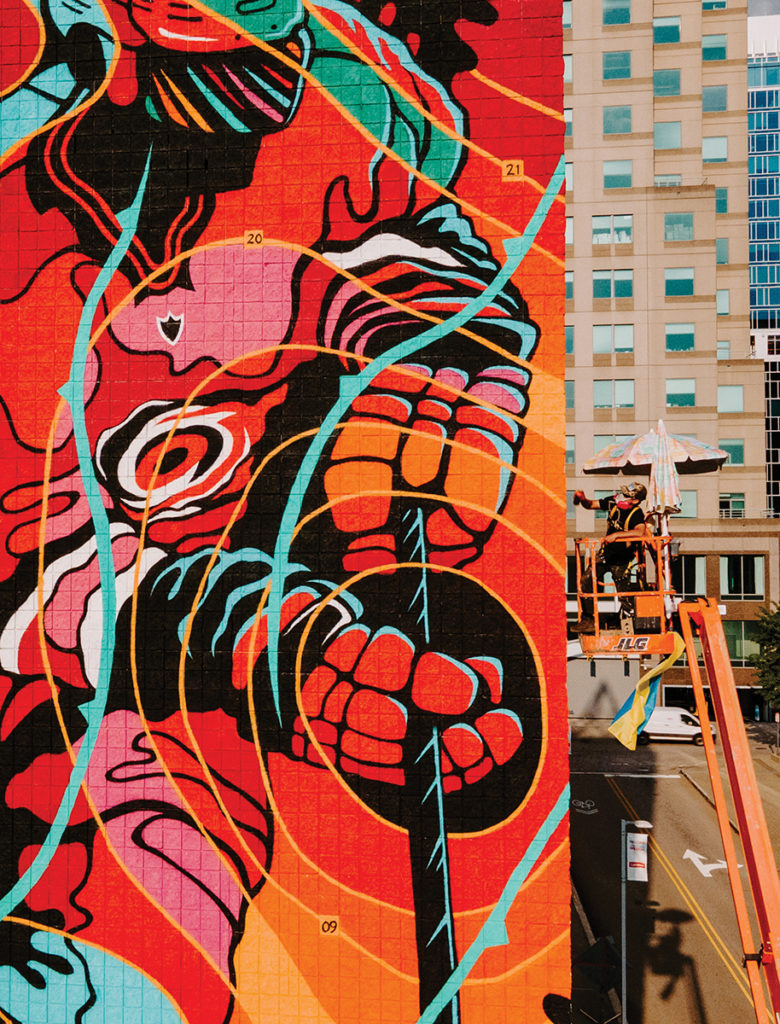
After a much-needed reset, Eng-Goetz returned to Durham and continued to scale up, focusing on public works projects that allowed him to continue to immerse himself in local communities within the state. Using his business acumen from his time with Runaway, Goetz began to build partnerships with state and municipal arts councils eager to support large-scale works.
As his portfolio grew, Eng-Goetz found an even bigger purpose for his art. “I became more interested in the power it has to tell a story of a community,” he says. Eng-Goetz felt compelled to visually represent different communities in civic works. In the fall, for example, he completed a mural in Morganton in partnership with the North Carolina Arts Council’s SmART initiative, a program committed to transforming downtown communities through art and sustainable economic development.
The mural, which was painted at the newly renovated Morganton Arts Council building, honors the rich history of textile work and the diverse communities they represent, from African-American Appalachian quilts to Hmong Story Cloth and woven Guatemalan textiles.
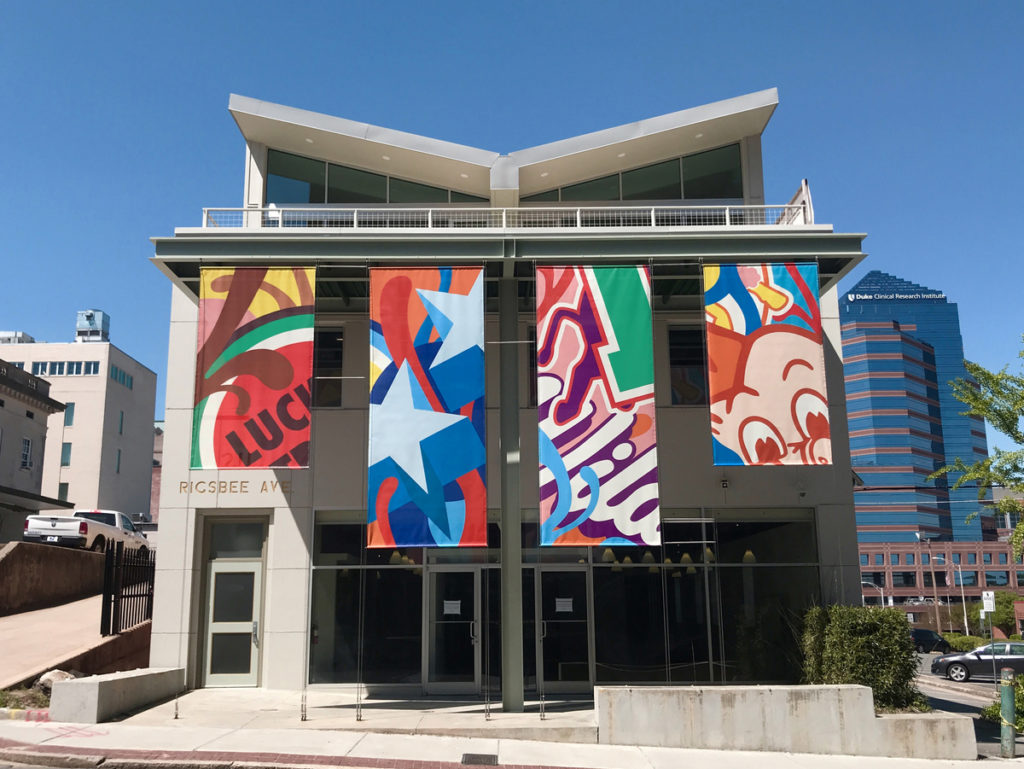
In September 2022, Eng-Goetz completed a mural on the corner of Hillsborough and West Streets in Raleigh that celebrates the history and transformation of Dix Park. Commissioned by the Dix Park Conservancy in partnership with the Downtown Raleigh Alliance, the Raleigh Murals Project and Trophy Brewing, the mural wraps sunflowers, ginkgo leaves and a Painted Bunting —a bird that captivated park visitors last summer — around a child that places an envelope near the base of a cut oak tree.
“I wanted the viewer to interpret what that letter means because I want the viewer to figure out what it is in their own minds,” says Eng-Goetz.
More subtle visual cues conjure the complicated history of the park, which sits on the ancestral land of Indigenous tribes including the Coharie, Lumbee and Occaneechee. A broken chain circling the base of the tree stump evokes the enslaved inhabitants of the Spring Hill Plantation, who worked the land before the sprawling site housed North Carolina’s first phsychiatric hospital.
The piece demonstrates how the past and present can coexist within the same space, while allowing room for growth and inclusivity. “Gabe’s work conveys Dix Park’s desire and intent to be a place for history and reflection, art and culture, and so much more,” says Nick Neptune, director of community outreach for the Dix Park Conservancy.
Each of his partnerships has offered room for self-discovery, and many of his murals explore Eng-Goetz’s mixed-race identity and Chinese ancestry. His mural at Boxyard RTP includes Chinese iconography like serpentine dragons with sharp talons, while in the Glenwood South district, Eng-Goetz evokes the pleasant comforts of home through a steaming bowl of noodles.
“Those projects are very important to me,” he says. “The Boxyard piece focused on the Asian immigrant story in areas like Apex, Morrisville and Cary. I wanted to tell that story and explore some of my own ancestry.”
In 2022, he installed an eye-popping sculpture made from wood, foam and found materials in the Artbox on Six Forks Road in North Hills called “Triple Delight,” featuring a majestic dragon head bearing sharp blue teeth and piercing yellow eyes. The piece ignited a renewed focus on a dormant medium for him. “When I went to Syracuse, I minored in sculpture and learned techniques like bronze casting, welding and mold making,” says Eng-Goetz.
“So I had that in my background, but hadn’t been using it throughout my career.” Upcoming projects include sculptural installations at Wake Tech and a large-scale public works project with the City of Raleigh.
While his public art projects keep Eng-Goetz booked and busy, Runaway still works with organizations on special, limited-edition branding projects like merchandise design for Eno Fest, Counter Culture Coffee and Trophy Brewing.
And flashes of the Runaway spirit appear in some of Eng-Goetz’s recent small-scale commissions. One recent custom painting takes form as a 4 ½-foot tall rabbit sculpture, which features signature nature elements like butterflies and lotus flowers over a spray-painted base. It’s one of 10 unique works by local artists that are placed throughout Airlie Gardens in Wilmington.
As Eng-Goetz continues to expand his public art practice in Wake County and beyond, he is learning about the cultures and communities that make the state so special. “I feel like I’m getting an education on North Carolina through these projects, whether it’s endemic species, the history of an area or different cultures,” he says. “It’s really cool.”
This article originally appeared in the February 2023 issue of WALTER magazine.

